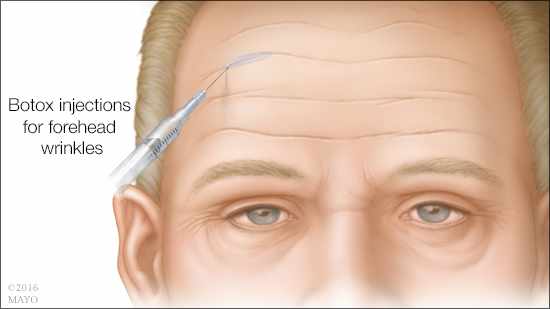-
Mayo Clinic Q and A: Botox for wrinkles – is it safe?

DEAR MAYO CLINIC: Does Botox work on deep forehead wrinkles, or do you have to catch them early for it to make a big difference? Is long-term use safe? What happens if I have the injections regularly for a few years, but then quit? Will my forehead look worse than if I had never gotten Botox?
ANSWER: All forms of Botox injections approved by the U.S. Food and Drug Administration for forehead wrinkles are intended for people 65 and younger. Beyond that, the medication may not be as effective as it is for younger individuals. Botox is safe to use long term, and you can stop using it at any time without your skin looking worse than it did before you started Botox. When used for cosmetic purposes, medical insurance does not cover Botox treatments.
Botox injections use forms of botulinum toxin to paralyze muscle activity temporarily. This toxin is produced by the bacterium that causes botulism, a type of food poisoning. Botox injections are popular for reducing the appearance of facial wrinkles. The injections are used to treat other medical conditions, too, such as repetitive neck spasms, excessive sweating, overactive bladder and lazy eye. The injections also may help prevent chronic migraines in some people.
Botulinum toxin injections block certain chemical signals from nerves, mostly signals that cause muscles to contract. This temporarily relaxes the facial muscles that underlie and cause wrinkles, including forehead furrows. Studies show that people who receive the most benefit from the injections are 65 and younger.
That is not to say, however, that people older than 65 can’t or shouldn’t use Botox. But, it is important to recognize that the results may not be as effective as in a younger population. For older adults to achieve the same results as younger patients, Botox should be used in combination with facial fillers injected into the skin to soften wrinkles.
For Botox injections, your health care provider uses a thin needle to inject tiny amounts of botulinum toxin into your skin. The number of injections you need will vary, depending on a variety of factors, including the size of the area being treated. Botulinum toxin injections usually begin working a few days after treatment. The effect may last up to three months or longer. To maintain the benefits of Botox, you need regular follow-up injections.
Botox has been shown to be safe for both short- and long-term use. Data for treatment of wrinkles with Botox only go back about 15 years. However, Botox for wrinkles uses a much smaller dose than patients receive for other conditions, such as muscle spasticity. Significant safety concerns have not been identified in people who receive larger doses of Botox for those other problems ─ further supporting its safety.
To ensure your safety, you should only receive Botox under the care of an experienced health care provider, such as a board-certified dermatologist, plastic surgeon, eye plastic surgeon or otolaryngologist who has personally examined you. These subspecialists have the most expertise to minimize complications and treat them if a complication occurs. Botox can be dangerous if it's given incorrectly. Although uncommon, Botox injections can produce side effects, including pain, swelling or bruising at the injection site, headache, flu-like symptoms, and eye dryness or excessive tearing, among others.
If you decide to stop using Botox, your forehead wrinkles will go back to the way they looked before you started the injections. Your face will not become more wrinkled as a result of Botox. Muscle strength and movement in your forehead also will return to normal when you discontinue Botox use. — Alina Bridges, D.O., Dermatology, Mayo Clinic, Rochester, Minnesota







